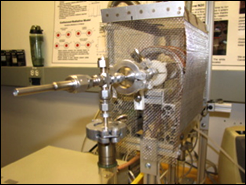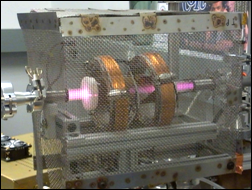Sponsor: N/A
Collaborators: N/A
 Nanoparticles have many potential magnetic, electronic and structural applications. Economic and large scale production of these materials is a significant challenge, and a variety of techniques are being pursued in the industry. Plasma dissociation of a precursor vapor has the potential to produce some of the smallest particles, however the power requirement using a thermal plasma is prohibitive for a low cost solution.
Nanoparticles have many potential magnetic, electronic and structural applications. Economic and large scale production of these materials is a significant challenge, and a variety of techniques are being pursued in the industry. Plasma dissociation of a precursor vapor has the potential to produce some of the smallest particles, however the power requirement using a thermal plasma is prohibitive for a low cost solution.
A Helicon plasma, a type of inductively coupled non-thermal plasma, has been used for nanoparticle production before, motivated by its anomalously high ionization efficiency. However, its need for a static magnetic field largely negates that benefit, since higher magnetic fields are desired for higher densities, but again come at the cost of electrical power.
 This project seeks to develop a nanoparticle reactor based on a superconducting helicon technology owned by the University of Maryland. The superconducting helicon source can provide a substantial magnetic field (~1 T) with virtually no power draw if cooled using liquid Nitrogen. This translates into both higher production rates and lower production costs for the nanoparticles. A prototype will be constructed and tested initially using Ferrocene to produce Iron nanoparticles, which with then be characterized by size distribution. The prototype will be used identify refinements to the reactor that will allow a commercial unit to be produced.
This project seeks to develop a nanoparticle reactor based on a superconducting helicon technology owned by the University of Maryland. The superconducting helicon source can provide a substantial magnetic field (~1 T) with virtually no power draw if cooled using liquid Nitrogen. This translates into both higher production rates and lower production costs for the nanoparticles. A prototype will be constructed and tested initially using Ferrocene to produce Iron nanoparticles, which with then be characterized by size distribution. The prototype will be used identify refinements to the reactor that will allow a commercial unit to be produced.
In its current state, a helicon plasma source using a conventional Helmholtz coil configuration has been constructed to evaluate the dissociation of the Ferrocene molecules and the ability to filter the nanoparticles out of the flow. Once the processing has been optimized, a better evaluation of the power requirements excluding the magnetic field generation can be made to predict the peroformance potential of the superconducting helicon source.